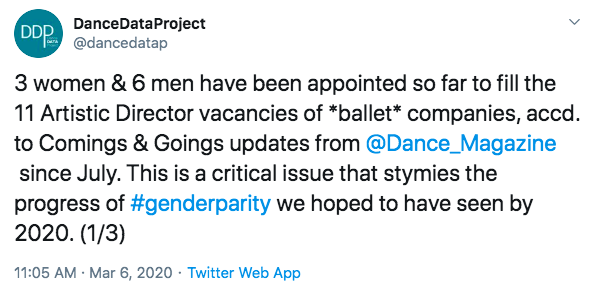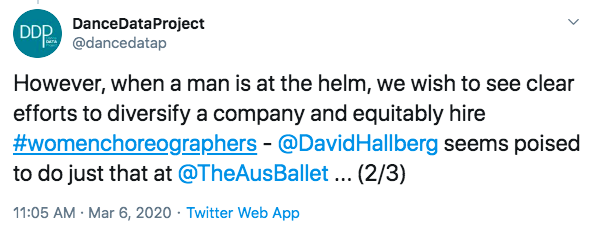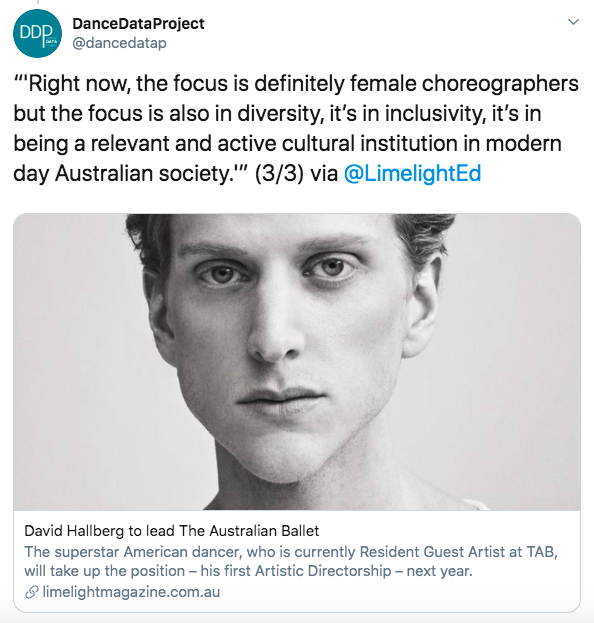DDP Talks To
"The Devil Ties My Tongue" by Amy Seiwert performed for the SKETCH Series, 2013. Photo by David DeSilva. Courtesy of Amy Seiwert's Imagery
December 31st: Jacob's Pillow: Ann & Weston Hicks Choreography Fellows Program, December 31st: New England Presenter Travel Fund, December 31st: Central Pennsylvania Youth Ballet Scholarship, December 31st: 24 Seven Dance Convention, December 31st: National Theater Project Presenter Travel Grant, December 31st: Breck Creek Artist-in-Residence Program, December 31st: Indigo Arts Alliance Mentorship Residency Program, January 22nd: Opera America Grants, March 3rd: Dance | NYC: Dance Workforce Resilience (DWR) Fund, March 31st: SIA Foundation Grants
×
"The Devil Ties My Tongue" by Amy Seiwert performed for the SKETCH Series, 2013. Photo by David DeSilva. Courtesy of Amy Seiwert's Imagery
Up to date announcements of company seasons, featured artists and special programming as well as grant of awards such as Princess Grace, or artistic appointments
By Farah Nayeri
28 February 2020
LONDON — The stirring sounds of Elgar’s Cello Concerto rise from the orchestra pit in an opening scene of a new production by the Royal Ballet, “The Cellist.” The ballerina in the title role settles into position with her instrument: a male dancer, dressed in brown tones. She grips his upstretched arm as if it were the neck of a cello and makes sweeping gestures across his back, as if moving a bow.
This rapturous musical union is suddenly interrupted, as the cellist collapses onstage, then rubs her hands, trying to chase away the numbness. Soon, her hands begin to quiver intermittently, as do her legs. Playing the instrument becomes impossible. Her human cello tries to revive her musical powers, as does her husband, who has been conducting from a nearby podium. They wrap themselves around her in a desperate embrace. But her musical career is permanently over.
Choreographed by Cathy Marston for the Royal Ballet, “The Cellist” tells the story of two highly gifted musicians: the cellist Jacqueline du Pré, considered one of the instrument’s finest musicians, and her husband, the star conductor and pianist Daniel Barenboim.
The two met in London in 1966 and married the next year, performing and recording together nonstop and forming one of the most memorable couples in classical music.
Read the full article here.
The Australian Ballet announced this week that famed American danseur David Hallberg would be the company’s next Artistic Director, effective January 2021.
Read the announcement here.
See DDP’s tweets on the subject in the shots below:



3 March 2020
The Joyce Theater Foundation (Linda Shelton, Executive Director) joins the worldwide celebration of the 250th anniversary of Beethoven’s birthday with its presentation of Trois Grandes Fugues, featuring three interpretations of the composer’s complex “Grosse Fuge” from a trio of trailblazing female choreographers – Lucinda Childs, Anne Teresa de Keersmaeker, and Maguy Marin – danced by Lyon Opera Ballet. The engagement will play The Joyce Theater from March 18-22. Tickets, ranging in price from $10-$55, can be purchased at www.Joyce.org, or by calling JoyceCharge at 212-242-0800. Please note: ticket prices are subject to change. The Joyce Theater is located at 175 Eighth Avenue at West 19th Street. For more information, please visit www.Joyce.org.
In Trois Grandes Fugues, three revolutionary female choreographers – Lucinda Childs, Anna Teresa de Keersmaeker, and Maguy Marin – each lend their distinct style to Beethoven’s intricate “Grosse Fuge” for a string quartet. Each choreographer is paired with a unique recording of the notoriously challenging composition in this triple bill of choreographic imaginings, danced by the exquisite artists of Lyon Opera Ballet. An inquiry into translation, Trois Grandes Fugues, explores how movement and musicality interact in distinct ways, demonstrating how the creative visions of musicians, dancers, and choreographers converge to create a truly novel interpretation that can never be duplicated.
Read the full article on Broadway World.
By Chava Lansky
2 March 2020
DDP Note: A lot of female choreographers featured by companies this week…
Colorado Ballet’s Newest Work Is Based on the Board Game Clue
Catch Colorado Ballet’s triple bill of contemporary works March 6–8 at the Ellie Caulkins Opera House. Titled Tour de Force, the program features Edwaard Liang’s Feast of the Gods, Lila York’s Celts and the world premiere of Julia Adam’s Cluedo. Featuring music by Cosmo Sheldrake, this new ballet is based on the board game Clue; check out rehearsal footage in the above video.
New Ballet Fantastique Full-Length Is Set in Ancient Ireland
Mother-daughter choreographic duo Donna and Hannah Bontrager, artistic directors of Ballet Fantastique, present their newest full-length ballet March 6–8. Dragon & the Night Queen is set in ancient Ireland, and explores magical worlds, dragons and epic battles. The ballet is set to a score by resident composer Gerry Rempel, who will play it live with Celtic rock and Irish traditional musician Eliot Grasso.
Carolina Ballet Celebrates Four Female Choreographers With Mixed Bill
Principal guest choreographer Lynne Taylor Corbett’s Boléro returns to Carolina Ballet March 5–22 on a mixed bill program celebrating female choreographers. Boléro, set to Maurice Ravel’s famed score, joins world premieres by three emerging dancemakers: Mariana Oliveira, Adriana Pierce and Carolina Ballet dancer Jenny Palmer.
Grand Rapids Ballet Presents World Premieres by Nine Company Dancers
This week, Grand Rapids Ballet gives company dancers the chance to showcase their choreographic chops. Jumpstart 2020, presented at the Peter Martin Wege Theatre March 6–8, features new works by nine artists: Yuka Oba-Muschiana, Gretchen Steimle, Adriana Wagenveld, Isaac Aoki, Nigel Tau, Matthew Wenckowski, Ednis Gomez, James Cunningham and Sophia Stefanopoulos.
Read the full article in Pointe.
3 March 2020
Carolina Ballet’s latest production is a showcase of talented female choreographers, as a way to celebrate and honor International Women’s Month.
See the original post on My Carolina.
By Lyndsey Winship
18 February 2020
Jacqueline du Pré danced with her cello. In concert footage, her body sighs and sways as her music soars. But it’s a leap from lyrical presence on the podium to transposing Du Pré’s tragically short life into dance, a challenge taken up by choreographer Cathy Marston in her first main stage commission for the Royal Ballet.
The Cellist comes in a double bill with Jerome Robbins’ 1969 Dances at a Gathering – Chopin piano, dreamy pastels, choreography of conversational nuance and lovely, subtle dancing – but it’s Marston’s ingenuity we’re all here to see. She is bold in having a dancer (Marcelino Sambé) embody the cello itself, kneeling in front of Du Pré (a radiant Lauren Cuthbertson), arm raised like the neck of the instrument as the cellist draws her hand across the air holding an invisible bow.
This picture spirals off into something more expansive, but they return to the motif. Mostly it seems to work, although there are cumbersome moments of pas de deux, not least due to the awkwardness of the cellist’s wide-legged stance. But there’s also the easy flow of bodies entwined, the way artist, instrument and music become one.
Composer Philip Feeney weaves extracts from Du Pré’s rep into his score and Marston has Du Pré and conductor Daniel Barenboim (Matthew Ball) fall in love on the concert stage, locking eyes over Elgar’s Cello Concerto. Aware of the music’s importance, Marston crowds the scene, with the imperious Ball dancing off the podium, an orchestra of dancers rising and falling and Cuthbertson changing from bright innocent girl to woman in love as we watch. It’s arguably an overload, although more generally the whirlwind of motion evokes exactly the giddy joy and genius shown in Christopher Nupen’s film The Trout, featuring Du Pré and Barenboim in their youthful prime.
Read the full review in The Guardian.
By Lauren Warnecke
Remember that scene in the movie “Footloose?” The one where Kevin Bacon drives into a warehouse in his VW bug, pulls a cassette tape out of the glove box, drinks a beer and dances like heck? I don’t know if Justin Peck was thinking about Kevin Bacon when he made “The Times Are Racing” for the New York City Ballet — after all, he wasn’t even born when that movie came out — but Peck, NYCB’s resident choreographer, captured something similar to that pent-up anger that drove Bacon to dance.
“The Times Are Racing” saw its Joffrey premiere on a mixed-rep program of the same name, through Feb. 23 at the Auditorium Theatre.
Dancer Edson Barbosa bounded across the stage — airborne more frequently than his feet, shod with white high-top sneakers, were on the ground — in tank top and jeans, sweat flying from his brow. But unlike Kevin Bacon in that warehouse, Barbosa isn’t alone. “The Times Are Racing” isn’t about getting out personal frustration; rather, it’s about how a collective of people can band together to create change in the world.
“The Times Are Racing” opens with a single dancer huddled by the company. Barbosa’s solo becomes a tap-dance inspired duet with Greig Matthews. A stunning pas de deux for Jeraldine Mendoza and Dylan Gutierrez (who gives the best performance of his career) repeats pretzel-like intricacies, mimicking the cumulative rise in energy that builds within selections from Dan Deacon’s iterative electronic score called “America.”
Dancing in sneakers affords these dancers the freedom to execute Peck’s larger-than-life choreography with reckless abandon, jumping higher and reaching farther than they could in their ballet slippers. They’re dressed in street clothes which give off an early 1990s vibe (styled by Humberto Leon of Opening Ceremony), but this is not a Gen X ballet. There’s an underbelly to “The Times Are Racing” that speaks directly to today’s deeply divided political landscape. That’s not to say millennials and Gen Z-ers are the only ones to experience political division. But Peck choreographed the piece during the 2016 presidential election — which is why it’s important to point out that this piece is actually not at all like “Footloose.” It’s not just virtuosic; it’s deeply personal to those dancers on stage. Of course, no Peck ballet is without commitment to technique and form, so any sense of cacophony is tempered by clean, crisp lighting by Peck’s frequent collaborator Brandon Sterling Baker, tightly organized formations and a blending of grounded pedestrianism from the waist down with perfectly balletic upper bodies.
Read the full review online here.
By Chava Lansky
Wonder what’s going on in ballet this week? We’ve rounded up some highlights.
In 2016, prolific choreographer Annabelle Lopez Ochoa created Broken Wings for English National Ballet, a short piece diving into the life of iconic Mexican artist Frida Kahlo. Soon after, Dutch National Ballet artistic director Ted Brandsen offered her the chance to expand that work into a full-length ballet. The result, simply titled Frida, makes its premiere February 6-25 in Amsterdam.
In collaboration with British composer Peter Salem and Dutch designer Dieuweke van Reij, Ochoa’s ballet explores Kahlo’s fraught relationship with artist Diego Rivera, her bisexuality, the physical and emotional pain she endured and the way that she crafted her own image through her paintings. Dutch National Ballet has put out a series of YouTube videos exploring the creation of the piece; catch the first one above.
Atlanta Ballet celebrates the rhythms and energy of jazz music this week in Heart/Beat: Gospel, Brubeck & Rhythms of the City, a triple bill of company premieres. The program, running February 7-15, includes Lar Lubovitch’s Elemental Brubeck to the music of Dave Brubeck, Alexander Ekman’s Tuplet to compositions by Mikael Karlsson and Victor Feldman, and Dwight Rhoden’s Sunrise Divine to an original score by Kevin Johnson.
Read the full article here.
11 February 2020
Boston Ballet Artistic Director Mikko Nissinen announces programming for the 2020-2021 season. The season opens with a world premiere as part of a three-ballet program of William Forsythe‘s works. Nissinen’s The Nutcracker returns to capture the imagination of audiences of all ages. The spring season includes a second world premiere by William Forsythe, Alexei Ratmansky’s Symphony No. 9, and George Balanchine‘s Ballo della Regina, plus the Company premiere of Christopher Wheeldon‘s A Midsummer Night’s Dream and the return of Marius Petipa’s The Sleeping Beauty. The season concludes with a female-led program, part of Boston Ballet’s ChoreograpHER Initiative. The Company’s 57th season runs November 5, 2020 through May 30, 2021 at the Citizens Bank Opera House.
“Our upcoming season is a dream come true with many new works by today’s greatest living choreographers paired with beloved classics,” said Artistic Director Mikko Nissinen.
The season opens with Triple Bill (November 5-15), featuring three works by creative powerhouse and internationally-acclaimed choreographer William “Bill” Forsythe. Just prior to the season opening, Boston Ballet will return to New York City to present this program at The Shed in October, which features a world premiere by Forsythe, co-commissioned by The Shed and Boston Ballet. Blake Works I returns by popular demand, transforming James Blake‘s “The Colour in Anything” into “sheer joy” (The New York Times). The international sensation Playlist (EP) returns after a record-breaking world premiere in Boston in March 2019 followed by the Company’s successful Paris debut in June. Playlist (EP) pulls pop and R&B music from Forsythe’s personal playlist to fuel the piece’s “high-kicking exuberance” (The Boston Globe). The program continues Forsythe and Boston Ballet’s long-term partnership formed in 2016.
…
The final program of the season is ChoreograpHER (May 20-30). The female-led program celebrates innovative voices across the art world with four new works. Dutch choreographer Nanine Linning will create her first work for a major ballet company in North America, pairing vivid imagery with strong physical movement. New York City Ballet Principal Dancer Tiler Peck will create a world premiere. She recently received accolades for her work at Vail International Dance Festival and directed movement for the film John Wick 3: Parabellum. Choreographer and Norwegian National Ballet Principal Dancer Melissa Hough, formerly a Boston Ballet Principal Dancer, returns to create a world premiere on the company where she got her start. Visual artist Shantell Martin-internationally-acclaimed for her landscape of lines and existential questions-will create a work in collaboration with Boston Ballet Principal Dancer and choreographer Lia Cirio. The program will also feature conceptual art by writer, researcher, and artist Emma McCormick-Goodhart. This program is part of Boston Ballet’s ChoreograpHER Initiative, a multi-year commitment in support of emerging female choreographers. It was established in 2018 to give female dance students and professional dancers an opportunity to develop choreographic skills.
Read the full article on Broadway World.
Reach out to us to learn more about our mission.
"The Devil Ties My Tongue" by Amy Seiwert performed for the SKETCH Series, 2013. Photo by David DeSilva. Courtesy of Amy Seiwert's Imagery
